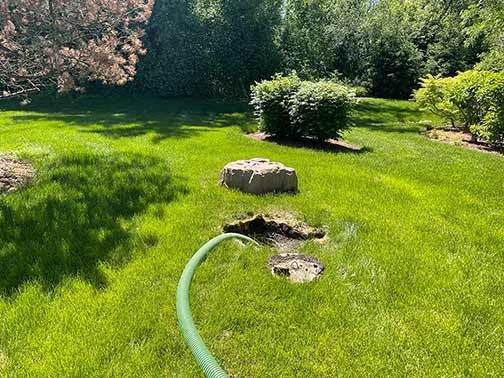
“How often should I have my septic tank pumped?”
Whenever you ask this question, you get several conflicting answers from well-meaning but often misinformed homeowners, says Keyrenter St. Louis West Management. In this post, we will dispel the misconceptions many people have about septic tank pumping and provide clear guidelines for pumping your septic tank.
How septic systems work
What are the components of your septic system?
- The tank: An underground concrete or fiberglass structure with a minimum capacity of 1000 gallons. It has two compartments – an inlet compartment and an outlet compartment – with a baffle in between to separate them.
- Inlet and outlet pipes: The inlet pipe transports wastewater from your home into the inlet compartment of the tank. The outlet pipe on the opposite side of the tank allows effluents from the outlet compartment to leave the tank.
- Drain field or leach field: Effluents enter the drain field pipes via a distribution box. These perforated underground pipes allow treated wastewater to slowly seep into the soil, where it will be further broken down by bacteria.
The normal operation of a septic system is as follows:
- Solid and liquid waste from the plumbing fixtures in your home enter the primary compartment of the septic tank and remain there for a while.
- While inside this compartment, the solid matter sinks to the bottom of the tank (sludge), while fats, oils, grease, and other materials float to the surface. The rest of the wastewater is broken down into effluents.
- Effluents enter the outlet tank via the baffle before being channeled into the drain field.
Why septic tanks need pumping
Septic tanks need to be pumped because as scum and sludge accumulate inside the tank, they start to interfere with the normal function of the septic system. If sludge and scum reach critical levels, they can eventually cause septic tank damage or septic system failure.
A septic system has failed when it is no longer able to efficiently treat wastewater, with the result that untreated sewage is released into the environment. A septic tank on the verge of failure will allow grease and solids to escape into the drain field, blocking the pipes.
A failed septic system will cause serious drainage problems in the home. The drains will be slow, and the smell of raw sewage will linger in the air. Water will pool on the surface of the drain field, and sewage may eventually back up into the house. This will attract pests into the property.
How often should you pump your septic tank?
The EPA (U.S. Environmental Protection Agency) recommends that septic tanks be pumped every 3-5 years. However, this is a broad guideline that does not say exactly when to pump your septic tank. To determine the right time to pump a septic tank, use the following rules.
Your septic tank should be pumped if more than 25% of its depth is sludge and scum. If the thickness of the scum layer at the top of the tank exceeds six inches or the sludge at the bottom of the tank is up to one foot thick, your septic tank need pumping.
Note that a full septic tank does not necessarily need to be pumped. Septic tanks are designed to operate fully. What is being measured is not the amount of liquid inside the tank but the levels of sludge and scum compared to the amount of liquid waste inside the tank.
Does your septic tank need pumping?
To know if a septic tank is full (full of sludge and scum, not simply full), you or an expert you hire should do the following.
- Remove the tank lid. Be careful not to break it or leave the open tank unattended.
- Check to see if there is floating scum on the water surface or a thick layer of scum. Stick a probe into the scum layer to see how thick it is.
- Next, check the sludge level at the bottom of the tank with a sludge-level measuring stick or a seven-foot strong pole designed for this purpose.
- If the scum layer on the surface is less than six inches and the sludge layer at the bottom is below the recommended pump-out level, there is no need to pump the tank.
- However, if the conditions inside your septic tank meet the EPA recommendations for septic tank pumping, pump the tank at once.
What are the likely consequences of not pumping your septic tank on time?
Your septic drain field will fail if your septic tank is not pumped. Grease that should have been contained inside the tank will escape into the leach field. If this happens, the drain field pipes will become clogged, and your leach field will fail.
The only way to fix a failed septic drain field is to replace it. The cost of doing that is between $30,000 and $45,000. On the other hand, pumping your septic tank only costs between $150 and $500, and you only need to pump the tank every 3-5 years.
Do you think your septic tank needs pumping? Give us a call at 224-335-8479.

